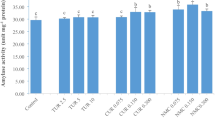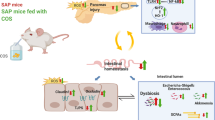Abstract
The experiment was conducted to evaluate the effect of copper-loaded chitosan nanoparticles on the small intestinal morphology and activities of digestive enzyme and mucosal disaccharase in rats. Forty male Sprague–Dawley rats, with average body weight of 82 g, were randomly allotted to five groups (n = 8). All rats were received a basal diet (control) or the same basal diet added with 80 mg/kg BW CuSO4, 80 mg/kg BW chitosan (CS-I), 80 mg/kg BW copper-loaded chitosan nanoparticles (CSN-I), 160 mg/kg BW copper-loaded chitosan nanoparticles (CSN-II), respectively. The experiment lasted 21 days. The results showed that the villus heights of the small intestinal mucosa in groups CSN-I and CSN-II were higher than those of the control, group CuSO4 or CS-I. The crypt depth of duodenum and ileum mucosa in group CSN-I or CSN-II was depressed. Compared with the control, there were no significant effects of CuSO4 or CS-I on the villus height and crypt depth of small intestinal mucosa. Supplementation with CSN improved the activities of trypsin, amylase and lipase in the small intestinal contents and maltase, sucrase and lactase of duodenum, jejunum, and ileum mucosa while there were no significant effects of CuSO4 on the digestive enzyme activities of the small content compared with the control. The results indicated that intestinal morphology, activities of digestive enzyme in digesta and mucosal disaccharase were beneficially changed by treatment of copper-loaded chitosan nanoparticles.
Similar content being viewed by others
Abbreviations
- CS:
-
Chitosan
- CSN:
-
Copper-loaded chitosan nanoparticles
- DL-BAPA:
-
Benzoyl-dl-arginine-p-nitotroanilide
References
Crini G (2005) Recent developemtns in polysaccharide-based materials used as absorbents in wastewater treatment. Prog Polym Sci 30:38–70
Shahidi F, Synowiecki J (1991) Isolation and characterization of nutrients and value-added products from snow crab (Chionoecetes opilio) and shrimp (Pandalus borealis) processing discards. J Agric Food Chem 39:1527–1532
Sinha VR, Singla AK, Wadhawan S, Kaushik R, Kumria R, Bansal K, Dhawan S (2004) Chitosan microspheres as a potential carrier for drugs. Int J Phytorem 274:1–33
Chien PJ, Seu F, Yang FH (2007) Effect of edible chitosan coating on quality and shelf life of sliced mango fruit. J Food Eng 78:225–229
Illum L (1998) Chitosan and its use as a pharmaceutical excipient. Pharmaceut Res 15:1326–1331
Nishimura K, Nishimura S, Nishi N, Saiki I, Tokura S, Azuma I (1984) Immunological activity of chitin and its derivatives. Vaccine 2:93–99
Mori T, Okumura M, Matsuura M, Ueno K, Tokura S, Okamoto Y, Minami S, Fujinaga T (1997) Effects of chitin and its derivatives on the proliferation and cytokine production of fibroblasts in vitro. Biomaterials 18:947–951
Porporatto C, Bianco ID, Correa SG (2005) Local and systemic activity of the polysaccharide chitosan at lymphoid tissues after oral administration. J Leukoc Biol 78:1–8
Hassan MAA, Li TP, Noor ZZ (2009) Coagulation and flocculation treatment of wastewater in textile industry using chitosan. J Chem and Natu Res Eng 4:43–53
Knorr D (1986) Nutritional quality, food processing and biotechnology aspects of chitin and chitosan: a review. Process Biochem 6:90–92
Zeng L, Qin C, Wang W, Chi W, Li W (2008) Adsorption and distribution of chitosan in mice after oral administration. Carbohydr Polym 71:435–440
Illum L, Jabbal-Gill I, Hinchcliffe M, Fisher AN, Davis SS (2001) Chitosan as a novel nasal delivery system for vaccines. Adv Drug Deliver Rev 52:117–126
Ilyina AV, Tikhonov VE, Albulove AI, Varlamov VP (2000) Enzymic preparation of acid-free-water soluble chitosan. Process Biochem 35:563–568
Xie W, Xu P, Wang W, Liu Q (2002) Preparation and antibacterial activity of a water soluble chitosan derivative. Carbohydr Polym 50:35–40
Xie Y, Liu X, Chen Q (2007) Synthesis and characterization of water-soluble chitosan derivate and its antibacterial activity. Carbohydr Polym 69:142–147
Yue W, Yao P, Wei Y, Li S, Lai F, Liu X (2008) An innovative method for preparation of acid-free-water-soluble low-molecular-weight chitosan (AFWSLMWC). Food Chem 108:1082–1087
Du WL, Xu Y, Xu ZR, Fan CL (2008) Preparation, characterization and antibacterial properties against E. coli K88 of chitosan nanoparticle loaded copper ions. Nanotechnology 19:0857071–0857075
Han XY, Du WL, Fan CL, Xu ZR (2010) Changes of composition and metabolism of caecal microbiota in rats fed with diets supplemented with copper-loaded chitosan nanoparticles. J Anim Physiol Anim Nutr 94:138–144
Goodlad RA, Levi S, Lee CY, Mandir N, Hodgson H, Wright NA (1991) Morphometry and cell proliferation in endoscopic biopsies: evaluation of a technique. Gastroenterology 101:1235–1241
Lowry OH, Rosenbrough NJA, Farr L, Randall RJ (1951) Protein measurement with the Folin phenol reagent. J Biol Chem 193:265–275
Erlanger BF, Kokowsky N, Cohen W (1961) The preparation and properties of two new chromogenic substrates of trypsin. Arch Biochem Biophys 95:271–278
Somogyi M (1960) Modification of two methods for the assay of amylase. Clin Chem 6:23–27
Tietz NW, Fiereck EA (1966) A specific method for serum lipase determination. Clin Chim Acta 13:352–355
Dahlqvist A (1964) Method for assay of intestinal disaccharides. Anal Biochem 7:18–25
Shurson GC, Ku PK, Waxler GL, Yokoyama MT, Miller ER (1990) Physiogical relationships between microbiological status and dietary copper levels in the pig. J Anim Sci 68:1061–1071
Furuse M, Okumura J (1994) Nutritional and physiological characteristics in germ-free chickens. Comp Biochem Physiol 109:547–556
Coates ME (1987) Gnotobiotics in nutritional studies. Die Nahrung 31:591–598
Hong KN, Park NY, Lee SH, Meyers SP (2002) Antibacterial activity of chitosans and chitosan oligomers with different molecular weights. Int J Food Microbiol 4:65–72
Montagne L, Pluske JR, Hampson DJ (2003) A review of interactions between dietary fibre and the intestinal mucosa, and their consequences on digestive health in young non-ruminant animals. Anim Feed Sci Technol 108:95–117
Conway PL (1994) The function of the gastrointestinal microflora and its regulation. In: Proceedings of the 6th international seminar on digestive physiology of pig, Sicuan. Science and Technology Press, Sicuan. pp. 233–242 (in Chinese)
Nichols BL, Avery S, Sen P, Swallow DM, Hahn D, Sterch E (2003) The maltose-glucoamylase gene: common ancestry to sucrase-isomaltase with complementary starch digestion activities. PNAS 100:1432–1437
Yao HT, Huang SY, Chiang MT (2008) A comparative study on hypoglycemic and hypocholesterolemic effects of high and low molecular weight chitosan in streptozotocin-induced diabetic rats. Food Chemical Toxicol 46:1525–1534
Acknowledgments
This work was financially supported by the Science and Technology Department of Zhejiang Province, China (grant no. 2008C22037). The authors thank Ying-Lei Xu and Xia Jiang for their skillful technical assistance.
Author information
Authors and Affiliations
Corresponding author
Rights and permissions
About this article
Cite this article
Han, XY., Du, WL., Huang, QC. et al. Changes in Small Intestinal Morphology and Digestive Enzyme Activity with Oral Administration of Copper-Loaded Chitosan Nanoparticles in Rats. Biol Trace Elem Res 145, 355–360 (2012). https://doi.org/10.1007/s12011-011-9191-x
Received:
Accepted:
Published:
Issue Date:
DOI: https://doi.org/10.1007/s12011-011-9191-x




